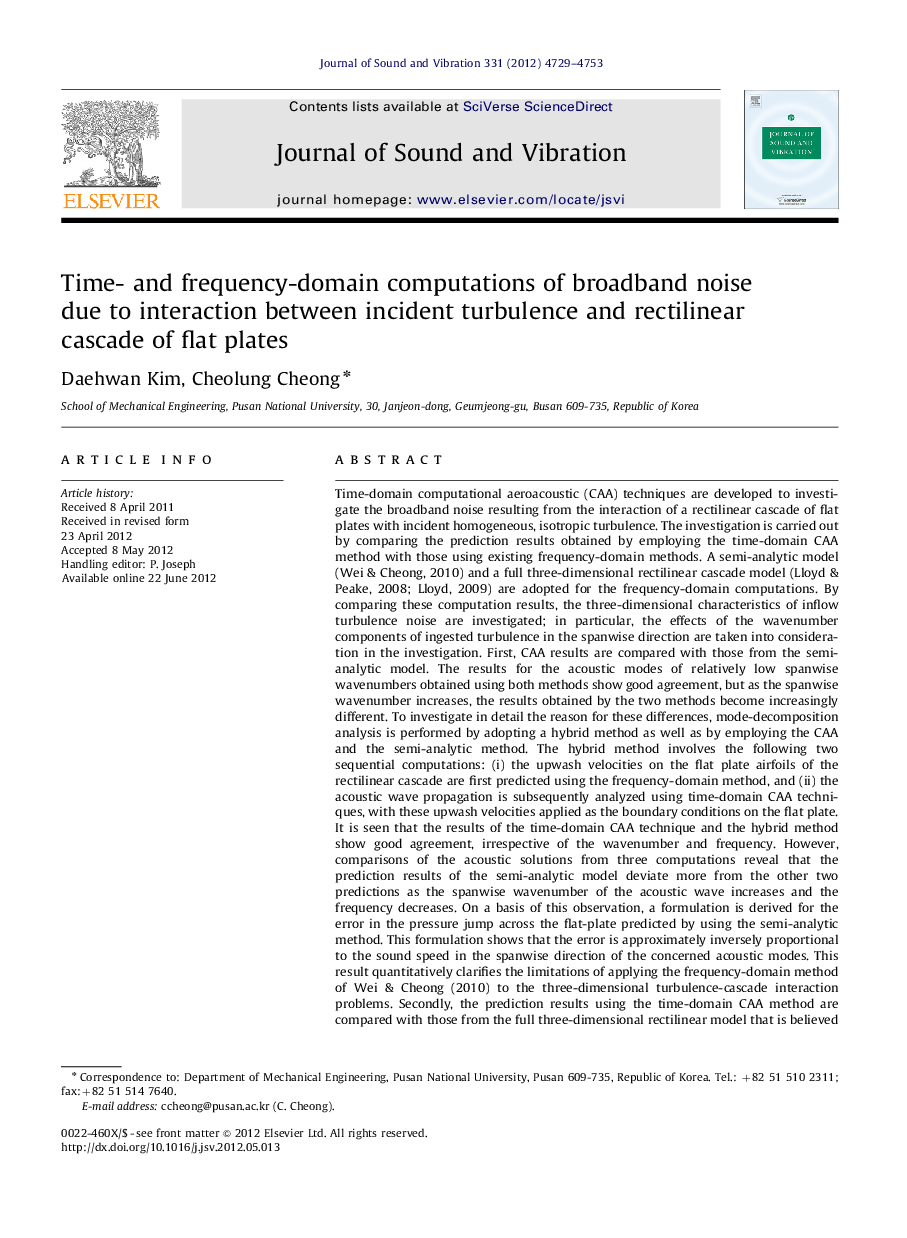| کد مقاله | کد نشریه | سال انتشار | مقاله انگلیسی | نسخه تمام متن |
|---|---|---|---|---|
| 288020 | 509599 | 2012 | 25 صفحه PDF | دانلود رایگان |

Time-domain computational aeroacoustic (CAA) techniques are developed to investigate the broadband noise resulting from the interaction of a rectilinear cascade of flat plates with incident homogeneous, isotropic turbulence. The investigation is carried out by comparing the prediction results obtained by employing the time-domain CAA method with those using existing frequency-domain methods. A semi-analytic model (Wei & Cheong, 2010) and a full three-dimensional rectilinear cascade model (Lloyd & Peake, 2008; Lloyd, 2009) are adopted for the frequency-domain computations. By comparing these computation results, the three-dimensional characteristics of inflow turbulence noise are investigated; in particular, the effects of the wavenumber components of ingested turbulence in the spanwise direction are taken into consideration in the investigation. First, CAA results are compared with those from the semi-analytic model. The results for the acoustic modes of relatively low spanwise wavenumbers obtained using both methods show good agreement, but as the spanwise wavenumber increases, the results obtained by the two methods become increasingly different. To investigate in detail the reason for these differences, mode-decomposition analysis is performed by adopting a hybrid method as well as by employing the CAA and the semi-analytic method. The hybrid method involves the following two sequential computations: (i) the upwash velocities on the flat plate airfoils of the rectilinear cascade are first predicted using the frequency-domain method, and (ii) the acoustic wave propagation is subsequently analyzed using time-domain CAA techniques, with these upwash velocities applied as the boundary conditions on the flat plate. It is seen that the results of the time-domain CAA technique and the hybrid method show good agreement, irrespective of the wavenumber and frequency. However, comparisons of the acoustic solutions from three computations reveal that the prediction results of the semi-analytic model deviate more from the other two predictions as the spanwise wavenumber of the acoustic wave increases and the frequency decreases. On a basis of this observation, a formulation is derived for the error in the pressure jump across the flat-plate predicted by using the semi-analytic method. This formulation shows that the error is approximately inversely proportional to the sound speed in the spanwise direction of the concerned acoustic modes. This result quantitatively clarifies the limitations of applying the frequency-domain method of Wei & Cheong (2010) to the three-dimensional turbulence-cascade interaction problems. Secondly, the prediction results using the time-domain CAA method are compared with those from the full three-dimensional rectilinear model that is believed to be exact model for the cascade geometry considered in this paper. This comparison shows the good agreements between two predictions, which support the above arguments for the error and the successful application of the time-domain CAA methods. It is expected that these methods can be extended to the broadband noise problem in an annular cascade, including the nonlinear interaction of the real-airfoil cascade with the incident nonhomogeneous gust.
Journal: Journal of Sound and Vibration - Volume 331, Issue 21, 8 October 2012, Pages 4729–4753